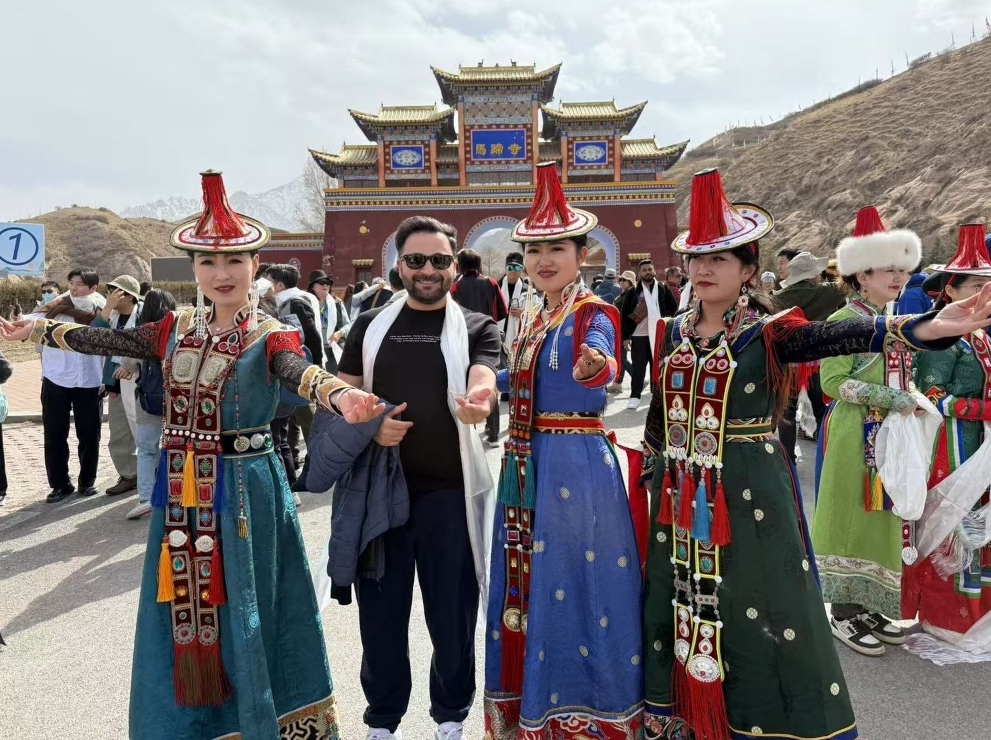A Journey to Gansu: Bridging East and West with the Spirit of the Silk Road

As the Chairman of the Belt and Road Initiative for Sustainable Development (BRISD), my travels often lead me to destinations that are steeped in history and promise. Yet, my recent visit to Gansu, and specifically to the ancient city of Dunhuang, has profoundly impacted me in ways I did not expect. This was my first time visiting Gansu, a region that sits at the crossroads of China’s cultural and historical heritage, where the East and West have long converged, and I have to admit—I’ve fallen in love.
The Silk Road, an ancient network of trade routes, is one of the greatest historical marvels the world has ever known. It connected China to the Mediterranean, Persia, India, and beyond, facilitating the exchange of goods, ideas, and cultures. Dunhuang, a once thriving oasis city on this route, is the embodiment of this convergence of civilizations. For centuries, it served as a critical juncture where East met West, and where art, knowledge, and commerce flowed freely.
As I made my way to Dunhuang, I was filled with a sense of anticipation. I had heard so much about its rich history, but nothing could prepare me for the emotional journey I was about to embark upon. The moment I arrived, I felt a deep sense of connection to a place that, in many ways, felt timeless. From the endless desert landscapes to the ancient architecture, every corner of this land whispered stories of travelers who had passed through centuries ago. It was as though the very air I breathed carried the wisdom and stories of the past.
Dunhuang is truly a place where the past and present coexist in harmony. The people here are deeply proud of their heritage, and they carry that pride with dignity and grace. As I interacted with the locals, I could feel their deep respect for the land, for their history, and for the Silk Road that had once connected them to the world. In their eyes, I saw a reflection of the same values that I hold dear—unity, peace, and the desire to build bridges between cultures.
One of the highlights of my trip was visiting the world-renowned Mogao Caves. These ancient Buddhist caves, carved into the cliffs of the Mingsha Mountains, are a testament to the cultural and religious exchanges that took place along the Silk Road. As I stepped into the cool, dimly lit interiors of the caves, I was immediately struck by the sheer beauty and artistry of the murals and sculptures that adorned the walls. These works of art, some over a thousand years old, tell the stories of Buddhist teachings, but they also depict the rich tapestry of cultures that once thrived along the Silk Road.
Each cave seemed to hold a different story, a different facet of the Silk Road’s vast cultural exchange. The colors in the murals were vibrant and intricate, showcasing not only the religious themes of Buddhism but also the influence of Persian, Indian, and Central Asian cultures. It was as though the walls themselves had absorbed the stories of all those who had passed through here—traders, monks, scholars, and explorers. It was impossible not to feel a deep sense of awe and humility in the presence of such history.
The Mogao Caves are a true marvel of preservation. The effort and care taken to protect this UNESCO World Heritage site are evident in every detail, from the high standards of maintenance to the sustainable tourism practices that ensure future generations can experience this wonder. The caves are not only a cultural treasure but also a symbol of how we can preserve our heritage for future generations while simultaneously fostering global understanding and dialogue.
In addition to the Mogao Caves, another unforgettable experience was visiting the Singing Sand Mountain. The vast expanse of golden sand dunes stretching across the desert was both awe-inspiring and humbling. As I climbed to the top of one of the dunes and listened to the soft, melodic hum of the wind blowing through the sand, I felt a sense of peace that is hard to describe. The Singing Sand Mountain is a place where the natural world and human history converge in a way that is almost magical. It reminded me of the countless travelers who, over the centuries, had journeyed along the Silk Road, enduring the harsh conditions of the desert but also experiencing its beauty and tranquility.
It was in moments like these that I truly understood the significance of Gansu and Dunhuang as a bridge between East and West. The Silk Road was not just a trade route; it was a conduit for cultural exchange, fostering mutual respect, understanding, and cooperation between civilizations. This spirit of integration is alive and well in Gansu today, and I was deeply moved by the region’s commitment to preserving its heritage while embracing the future.
The Gansu I encountered was a place of vitality and optimism. The region is not only rich in history and culture but is also focused on sustainable development and environmental preservation. I was impressed by the region’s commitment to green tourism and sustainable practices, ensuring that the beauty of Gansu will be preserved for future generations. The facilities available to tourists are of international standard, and they are designed to ensure that visitors can experience the region’s wonders while also respecting the environment.
It was during this trip that I realized the potential for Gansu to become an even more vital player in the global conversation about sustainability, heritage preservation, and cultural diplomacy. As I reflected on my experiences, I shared with my team that we must establish a Silk Road Research Center under the Belt and Road Initiative for Sustainable Development (BRISD) in collaboration with Gansu. This center would be dedicated to promoting Silk Road civilization globally and fostering deeper understanding and cooperation between cultures.
I envision this center as a hub for high-level research and diplomacy, where scholars, diplomats, and cultural leaders from around the world can come together to learn from the past and work toward a sustainable future. Gansu’s unique position as a crossroads of civilizations makes it the perfect location for such an initiative. The spirit of the Silk Road is still alive here, and it serves as a constant reminder of what we can achieve when we work together across borders, cultures, and continents.
As my time in Gansu came to a close, I was filled with a deep sense of gratitude and inspiration. The region had not only opened my eyes to the rich history of the Silk Road but had also reminded me of the power of cultural exchange and collaboration. Gansu is a place where history comes alive, where cultures meet and blend, and where the spirit of the Silk Road continues to thrive.
I cannot recommend Gansu enough to those who are seeking a destination that is rich in history, culture, and natural beauty. For those traveling from outside China, Dunhuang and Gansu offer an unparalleled opportunity to experience the wonders of the ancient Silk Road and witness firsthand the remarkable fusion of East and West. It is a journey that will touch your heart and soul, and like me, you may find yourself falling in love with this extraordinary region.
Gansu is not just a place to visit; it is a place to connect with the past, embrace the present, and look toward the future. It is a living, breathing testament to the power of integration, and I am proud to share its beauty and significance with the world.


